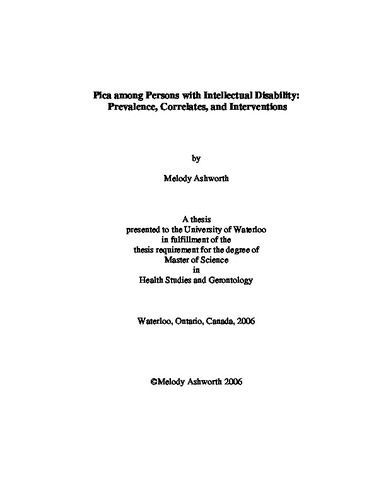| dc.description.abstract | <b>Background:</b> Individuals with intellectual disabilities (ID) have a higher prevalence of comorbid psychiatric disorders and challenging behaviours compared to the general population. Though less common, one area of concern among those with ID is pica (the ingestion of inedible substances). To date, there is little knowledge of pica, particularly with respect to its risk factors and social consequences. The closure of Ontario's three remaining facilities by 2009 underscores the importance of having knowledge of complex behaviours such as pica for improving supports and services in the community for these individuals. The aim of this study is to better understand the characteristics and support needs of adults with ID and pica. This study is comprised of a quantitative and qualitative component. <b>QUANTITATIVE STUDY</b> <b>Objectives:</b> To investigate the prevalence, risk factors, social and medical characteristics of pica. To determine how pica is managed in terms of hours of supervision, receipt of interventions, and psychotropic medication. <b>Methods:</b> Secondary data analysis was performed on two samples as part of cross-sectional study: 1008 persons with ID from Ontario's facilities and 420 community-dwelling adults with ID from southwestern Ontario. All persons had been assessed using the interRAI Intellectual Disability (interRAI ID)?a comprehensive and standardized instrument that measures a variety of domains for support planning. Bivariate and multivariate analyses were restricted to the facility sample due to the small size of persons with pica in the community. <b>Results:</b>The overall prevalence of pica was 22. 0% and 3. 3% in the facilities and the community, respectively. Logistic regression analysis showed that being male, cognitive functioning, autism, and being non-verbal were associated with a higher odds of having pica, whereas activities of daily living (ADL) was a protective factor. A quadratic relationship was observed between cognitive function and pica: the risk of pica increased with severity of cognitive impairment up to moderate to severe levels of impairment and then diminished among those with very severe cognitive impairment. Behaviour management, self-care skills, and 8 hours or more of one-to-one supervision were more likely to be provided to persons with pica. Compared to persons without pica, persons with pica had higher rates of being prescribed antipsychotic medication. Surprisingly, pica was not associated with higher rates of gastrointestinal health problems, with the exception of acid reflux. The negative social outcomes of pica, however, were many: pica was associated with higher odds of not having a strong and supportive relationship with family, lack of contact with family or other close relations, and absence of participation in social and recreational activities.
<b>QUALITATIVE STUDY</b> <b>Objective:</b> To determine the support needs of adults with ID and pica from the perspective of direct-care staff of facility and community settings. <b>Methods</b>: Through two focus groups, the perspectives of four staff from Huronia Regional Centre (HRC), and six staff from community agencies from southwestern Ontario were examined. Transcripts were analyzed thematically for factors that facilitated or hindered the management of pica. <b>Results:</b> Qualitative data revealed three categories that underpinned reduction in pica: preventative measures (environmental controls, close supervision, and the provision of alternative activities), formal supports, and familiarity with the individual. On the other hand, inadequate staff support, lower functioning level of the individual, and lack of knowledge acted as barriers to managing and reducing pica. These barriers were associated with persons participating in fewer recreational activities and community outings, and in some cases the use of mechanical restraints. Barriers specific to each setting in the management of pica were also illuminated. Staff in both settings tended to be self-sufficient and isolated in managing this complex behaviour. <b>Conclusions:</b> Results suggest that attention should be equally paid to the potential social consequences of pica rather than solely to its health risks. Higher staff to client ratios, and training and education for staff to provide more active support to promote individuals' engagement in recreational activity and community integration is needed. Key recommendations also focus on educating and training staff on the risk factors and appropriate management of pica. Improving the collaboration and knowledge exchange among developmental service agencies is also recommended to enhance the management of pica among caregivers. Lastly, the community at large needs education on pica to foster more inclusive community living for those with ID. | en |

